Foreign Insulators
by Marilyn Albers
Reprinted from "Crown Jewels of the Wire", February 1999, page 16
THREE NEW INSULATOR FINDS
FROM AUSTRALIA
Insulator collectors Peter and Jenny Cash of Cootamundra, New South Wales,
Australia, wrote to me about the discovery of three unusual porcelain pieces
they found in their neighboring state of Victoria. The first insulator is shown
below.
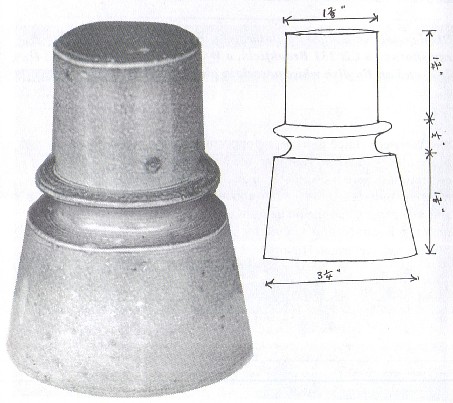
Rare pottery type insulator with a brown salt glaze and
Peter's sketch of the
insulator with measurements.
This unmarked pottery type insulator with a threaded pin hole is extremely
rare. The outside of it is covered with a rich brown salt glaze, but none of the
inside part is glazed, which leaves the threads in a pretty rough condition.
Peter says he has never seen this shape before and thinks it is quite old,
probably dating back to the 1880' s. My guess is that it was made in England
where salt glazes were commonly used on insulators during that time, then
exported to Australia for use on lines there. Why do I think so? Because some of
the British made Varley type insulators with the same type of brown salt glaze
(U -1363's and U-1364's) were also exported to different parts of Australia
and New Zealand. Similar styles have been found in Canada, but now all of these
old pottery types are scarce. The few that remain in collections are veritable
treasures!
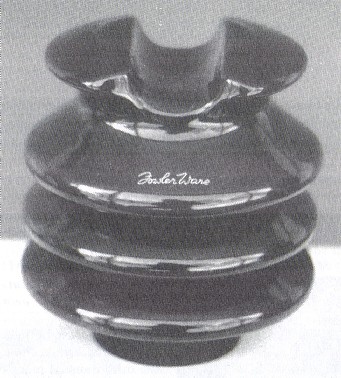
A 'Fowler Ware' insulator?
Peter goes on to describe his second insulator find, which at first glance
looks like an authentic insulator. He says "I think this piece is very
interesting and is probably meant for a traveler because it comes apart at the
middle and the base is molded around to form a shallow container. It is perhaps
a paper clip holder that was meant to sit on an office desk.
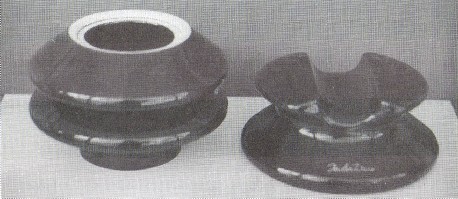
Or a 'Fowler Ware' Go-with?
The photograph above shows the unit taken apart. The front of the top section
is marked 'Fowler Ware' and '6 F L P I I' appears on the opposite side. The item
is 5" tall, the inside bowl depth is 2-1/2", and all is very nicely finished
in a dark chocolate brown glaze.
The trademark Fowler Ware indicates that this
item was made by Fowler Potteries in Sydney, Australia., which existed through
at least three generations, certainly through the 40's, 50's and 60's. Fowler
was the family name and brothers were involved in the ownership of the company.
Insulators were marked 'F.B.' (Fowler Brothers), 'R.F. Ltd.' (Robert Fowler
Ltd.) or just 'Fowler'. Peter's paper clip holder (?) would be highly prized by
any collector of foreign insulator go-withs. Hopefully, he and Jenny will find
some more of these. I'm holding up my hand!
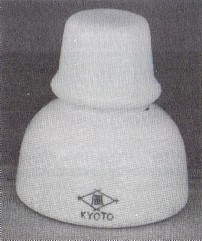
A sub insulator of Japanese origin
The white bell shaped insulator shown at the left is the third unusual piece
our travelers found in Australia. It is 3-1/4" tall and has a base diameter
of 3-1/8". Peter calls it a sub insulator, because it was used for
subscriber telephone lines rather than for long distance, and says the 'KYOTO'
marking indicates that the insulator was made in Japan. I'm going to assume this is the name of
the manufacturer. Notice the unusual diamond trademark on the skirt. It is
stamped on some of my other foreign porcelain insulators but the name 'KYOTO'
has never appeared on any of them, so I've never known what country they came
from until now.
The porcelain bell shaped insulators are used everywhere in
Australia because they work well on the lines there. The larger ones measure
approximately 5-1/4" in height while the smaller sub insulators are usually
about 3-1/4" to 3-1/2" tall. Both sizes have an inner skirt and an
Australian threaded pin hole (7 threads per inch). Most of the early bells were
produced locally by Australian companies, but they soon discovered it was
cheaper to import insulators from other countries like Great Britain, Japan and
Czechoslovakia, which explains the variety of different markings found on the
insulators.
Looking through my own collection of sub insulators, I lined up four
that are obviously of Japanese origin: (1) 'FK' within a double diamond over
'Made in Japan', (2) an 'NGK' triangle with an insulator in the center, (3) 'K'
within a diamond over 'Made in Occupied Japan' and (4) one that's just marked
'Made in Japan'. Two others have the trademarks 'F.B.' and 'R.F.Ltd'. and the
rest are completely unmarked.
Peter and Jenny, many thanks for sharing your
special finds with us. May you continue to have success in finding good
insulators.
A CHUBBY GRANDMA JOINS THE GROWING GINGERBREAD FAMILY

The whole gingerbread family - so far!
I thought we'd already discovered all the various shapes and sizes of the
gingerbread family, but when Dale Huber of Colfax, California brought this chubby porcelain insulator to my table at the
Williamsburg National Show I knew it warranted a place of honor in the
gingerbread line-up as a 'grandma'. Dale said it was either found in France or
Belgium It weighs a full 2-1/2 lbs, so it's not the sort of thing you'd carry
in your pocket, but when you find something special like this there is always a
way to get it home, heavy or not. Just ask my husband Bill!
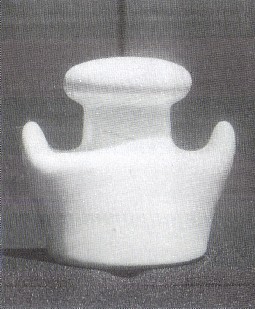
New to the line up -
a gingerbread Grandma
This insulator is 5" tall, with a base diameter of 3-5/8" and an
arm span of 5". It has an inner skirt and a 1-3/8" pin hole with tiny
threads (7 per inch). There is no marking on the piece, which is typical of most
gingerbreads made of porcelain, but because so many variations of this style
were made and used in France, I suspect this particular one is of French origin.
Jim Bergman of Anchorage, Alaska has an insulator just like the one I've
described above, only his is a bit larger. It measure 5-3/8" in height, the
base diameter is 4-1/2", and the arm span is a full 6" from tip to
tip. He told me he found his insulator in a small town in France. Luckily, it
was just sitting on the ground by the side of the road so he picked it up. He
also saw several of them in service on power cables running along the main
street of the town, so it's obvious these insulators were intended for use on
high voltage lines.
| 